- INTERNAL - Bepoz Help Guides
- End-User | Products & SmartPOS
- Product Maintenance
-
End-User | Products & SmartPOS
-
End-User | Stock Control
-
End-User | Table Service and Kitchen Operations
-
End-User | Pricing, Marketing, Promotions & Accounts
- Prize Promotions
- Points, Points Profiles and Loyalty
- Product Promotions
- Repricing & Discounts in SmartPOS
- Vouchers
- Account Till Functions
- Pricing, Price Numbers and Price Modes
- Raffles & Draws
- Marketing Reports
- Accounts and Account Profiles
- Rewards
- SmartPOS Account Functions
- Troubleshooting
- Product Labels
- Packing Slips
-
End-User | System Setup & Admin
-
End-User | Reporting, Data Analysis & Security
-
End-User | Membership & Scheduled Billing
-
End-User | Operators, Operator Permissions & Clocking
-
Interfaces | Data Send Interfaces
-
Interfaces | EFTPOS & Payments
- NZ EFTPOS Interfaces
- Linkly (Formerly PC-EFTPOS)
- Adyen
- Tyro
- ANZ BladePay
- Stripe
- Windcave (Formerly Payment Express)
- Albert EFTPOS
- Westpac Presto (Formerly Assembly Payments)
- Unicard
- Manager Cards External Payment
- Pocket Voucher
- OneTab
- Clipp
- eConnect-eConduit
- Verifone
- AXEPT
- DPS
- Liven
- Singapore eWallet
- Mercury Payments TRANSENTRY
- Ingenico
- Quest
- Oolio - wPay
-
Interfaces | SMS & Messaging
-
Interfaces | Product, Pricing, Marketing & Promotions
- Metcash Loyalty
- Range Servant
- ILG Pricebook & Promotions
- Oolio Order Manager Integration
- Ubiquiti
- Product Level Blocking
- BidFood Integration
- LMG
- Metcash/IBA E-Commerce Marketplace
- McWilliams
- Thirsty Camel Hump Club
- LMG Loyalty (Zen Global)
- Doshii Integration
- Impact Data
- Marsello
- IBA Data Import
- Materials Control
- Last Yard
- Bepoz Standard Transaction Import
-
Interfaces | Printing & KDS
-
Interfaces | Reservation & Bookings
-
Interfaces | Database, Reporting, ERP & BI
-
Interfaces | CALink, Accounts & Gaming
- EBET Interface
- Clubs Online Interface
- Konami Interface
- WIN Gaming Interface
- Aristocrat Interface
- Bally Interface
- WorldSmart's SmartRetail Loyalty
- Flexinet & Flexinet SP Interfaces
- Aura Interface
- MiClub Interface
- Max Gaming Interface
- Utopia Gaming Interface
- Compass Interface
- IGT & IGT Casino Interface
- MGT Gaming Interface
- System Express
- Aristocrat nConnect Interface
- GCS Interface
- Maxetag Interface
- Dacom 5000E Interface
- InnTouch Interface
- Generic & Misc. CALink
-
Interfaces | Miscellaneous Interfaces/Integrations
-
Interfaces | Property & Room Management
-
Interfaces | Online Ordering & Delivery
-
Interfaces | Purchasing, Accounting & Supplier Comms
-
SmartPOS | Mobile App
-
SmartPDE | SmartPDE 32
-
SmartPDE | Denso PDE
-
SmartPDE | SmartPDE Mobile App
-
MyPlace
-
MyPlace | myPLACE Lite
-
MyPlace | Backpanel User Guides
- Bepoz Price Promotions
- What's on, Events and tickets
- Staff
- System Settings | Operational Settings
- Vouchers & Gift Certificates
- Member Onboarding
- Members and memberships
- System Settings | System Setup
- Reports and Reporting
- Actions
- Offers | Promotions
- Messaging & Notifications
- System Settings | App Config
- Surveys
- Games
- User Feedback
- Stamp Cards
-
MyPlace | Integrations
-
MyPlace | FAQ's & How-2's
-
MyPlace | Release Notes
-
YourOrder
-
YourOrders | Backpanel User Guides
-
YourOrders | YourOrder Kiosk User Guide
-
YourOrders | Merchant App User Guide
-
WebAddons
-
Installation / System Setup Guides
- SmartPOS Mobile App | Setup
- SmartPOS Mobile App | SmartAPI Host Setup
- SmartPOS Mobile App | BackOffice Setup
- SmartPOS Mobile App | Pay@Table setup
- SmartKDS Setup 4.7.2.7 +
- SmartKDS Setup 4.6.x
- SQL Installations
- Server / BackOffice Installation
- New Database Creation
- Multivenue Setup & Config.
- SmartPOS
- SmartPDE
- Player Elite Interface | Rest API
- Interface Setups
- Import
- KDSLink
- Snapshots
- Custom Interface Setups
-
HOW-2
- Product Maintenance
- Sales and Transaction Reporting
- SmartPOS General
- Printing and Printing Profiles
- SQL
- Repricing & Discounts
- Stock Control
- Membership
- Accounts and Account Profiles
- Miscellaneous
- Scheduled Jobs Setups
- Backoffice General
- Purchasing and Receiving
- Database.exe
- EFTPOS
- System Setup
- Custom Support Tools
-
Troubleshooting
-
Hardware
11 | Product-Supplier Options
This article covers options for Product Suppliers including how Products can be linked to Suppliers within BackOffice. Additionally, this article covers other Supplier-related features of Product Maintenance.
This article covers options for Product Suppliers including how Products can be linked to Suppliers within BackOffice. Additionally, this article covers other Supplier-related features of Product Maintenance.
Prerequisites
- To access and edit Product Supplier Options, the applicable Operator Privileges will need to be enabled:
-
Operator Maintenance 'Maintenance' Tab - All "Products" Flags
-
Operator Maintenance 'Stock Control' Tab - Purchasing & Receiving: "Create / Edit Purchase Orders" Flag
Preferred Supplier Drop-down
- The Preferred Supplier for a
Product can be set by Store using a drop-down which is located on theStore/Pricing Settings tab of the Product Maintenance window - The drop-down options will include all of the
Suppliers in the System's database along with an option called 'Use Product Setting'
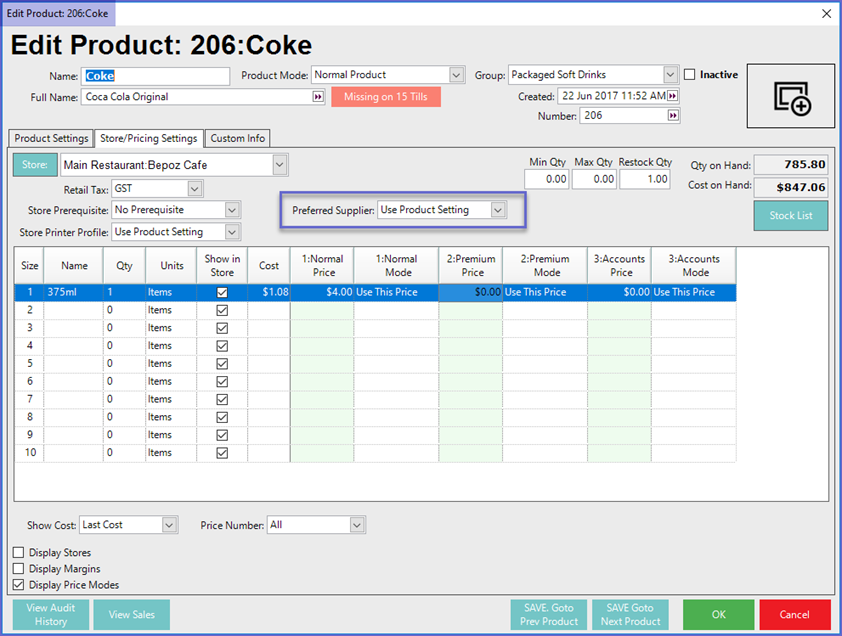
- If the "Use Product Setting" option is selected, the Preferred Supplier as set in the Product Settings will be used
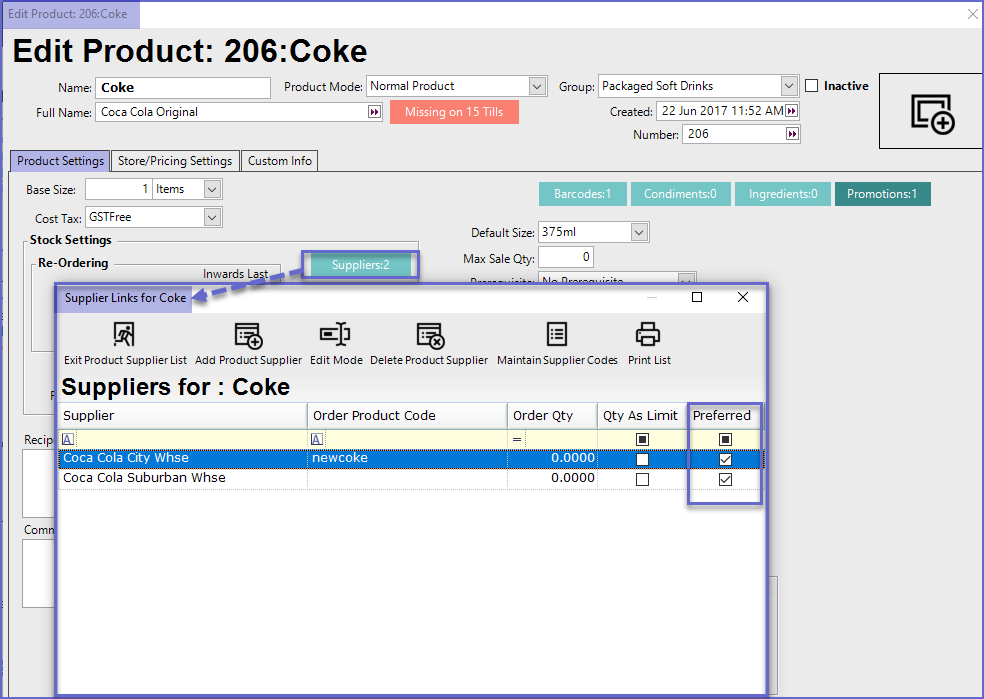
- This allows for each Store to have a different Preferred Supplier if required when using
Auto PO processes orRequisitions - This may be needed in situations where Stores in different locations receive (or prefer to) a Product from Suppliers that are specific to the Stores' location
- For example, if an Organisation has a Store in Town Centre and a Warehouse Cafe in a Suburb and they also have two suppliers for Coca-Cola, one for each location
- The customer can configure the Town Centre Restaurant store to have the Preferred Supplier as the Coca-Cola City Whse for their Coca-Cola Products, while the Warehouse Cafe can configure the Coca-Cola Suburban as their Preferred Supplier
- Even if the customer has a Preferred Supplier set for the Product overall
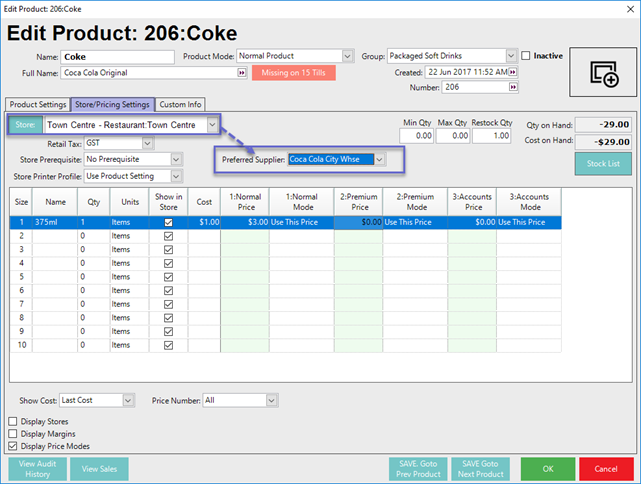
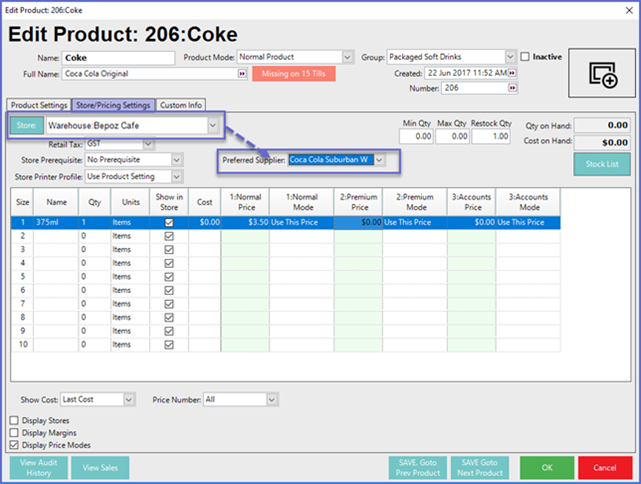
Multiple Supplier Codes
- This function is accessible via the Maintain Supplier Codes button when opening the Supplier Links window for a Product
- To Add a New Supplier Code, go to Product Maintenance and follow the given steps:
- First, open the desired Product and select the Suppliers button from the Stock Settings section which will open the Supplier Links window for that Product
- From the Supplier Links window, select the Maintain Supplier Codes button from the header section which will open the Supplier Codes window for the Product
- Select the Add Product Code from the Supplier Codes window
- A prompt will display allowing entry of the New Supplier Code; enter the code and click OK
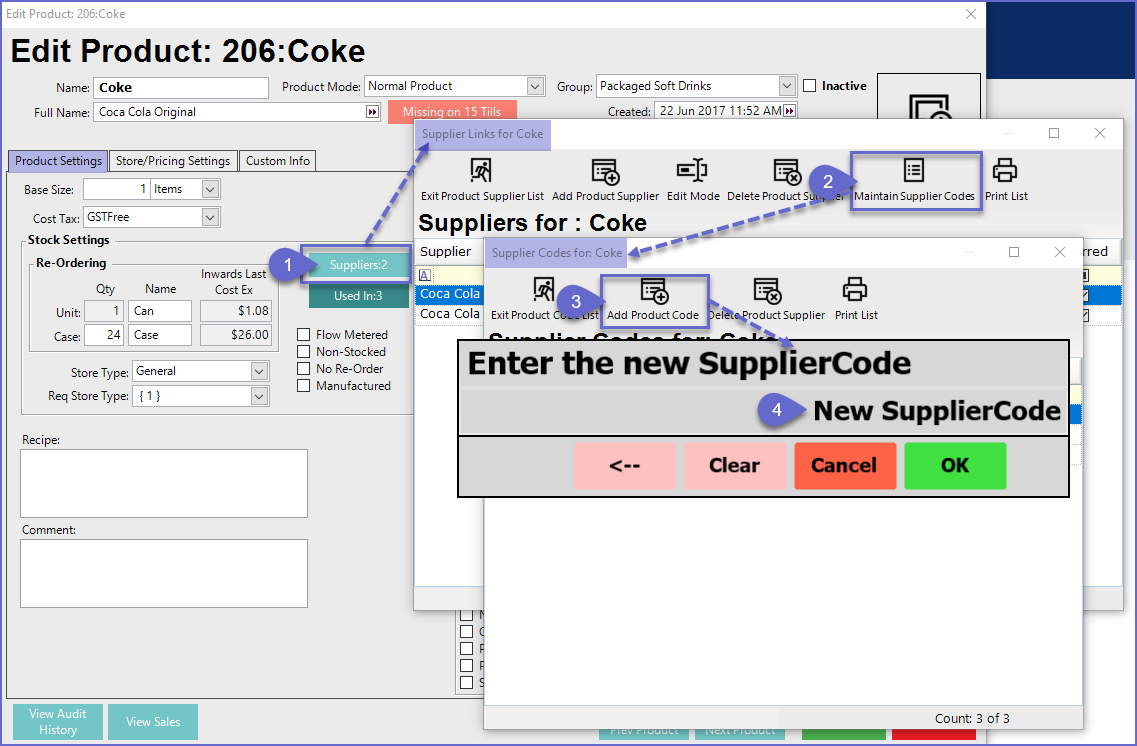
- To Delete a Supplier Code, highlight & select the Delete button
Supplier Product Code Drop-Down
- To set a Default Supplier Code, use the Edit Mode from the Supplier Links window, then choose the desired Code from the drop-down
- To enter Edit Mode, either click the Edit Mode button within the header section or double-click anywhere on the list
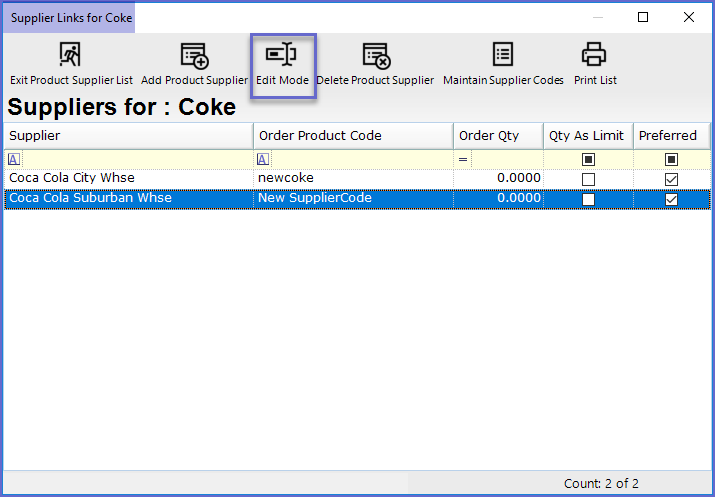
- After entering into Edit Mode, a drop-down containing the available Supplier Codes for each Product will be accessible
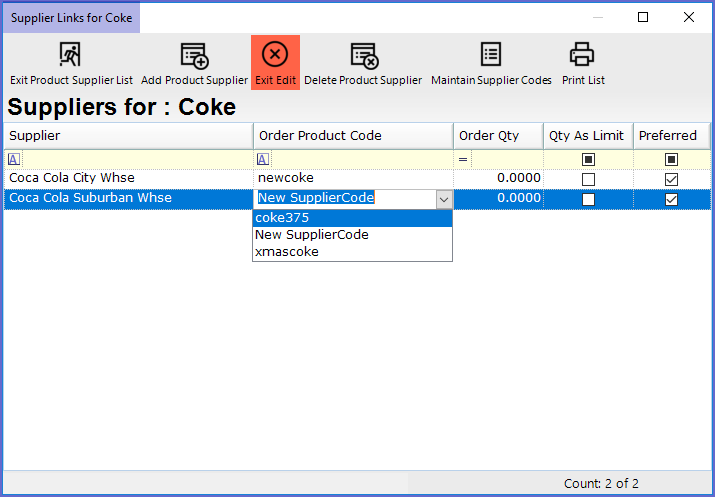
- Select the desired Code and click Exit Edit
- The selected Code will now be the PO Default Supplier Code
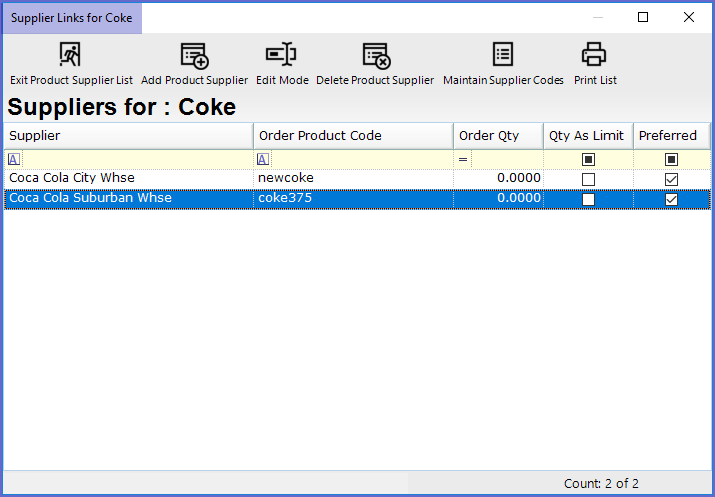
- When creating a PO and adding this Product, the PO Default Product Code will be entered as the Supplier Code

- If the Supplier Code is changed when creating a new Purchase Order, the following Warning Message will appear; select Yes to set the Supplier Code as the PO Default
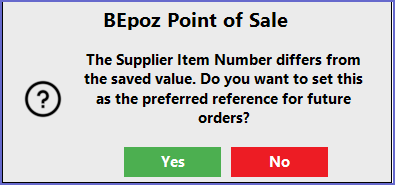
- If no Code is marked as the PO Default, a Supplier Code will not be automatically entered when creating a PO
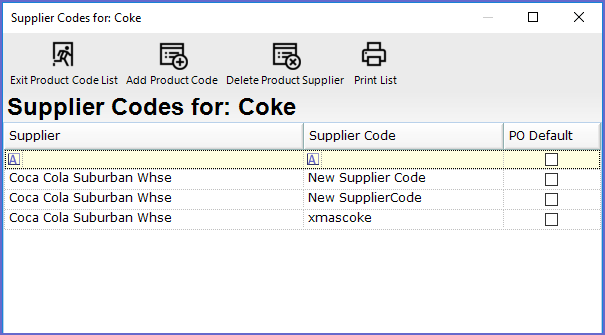
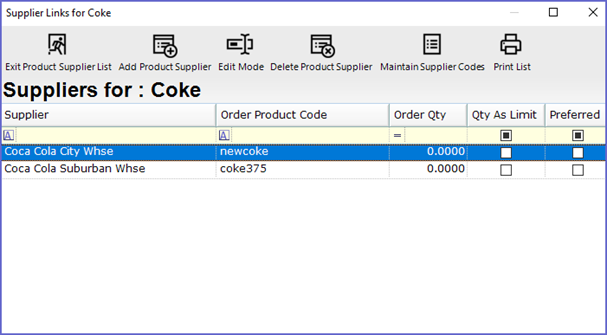
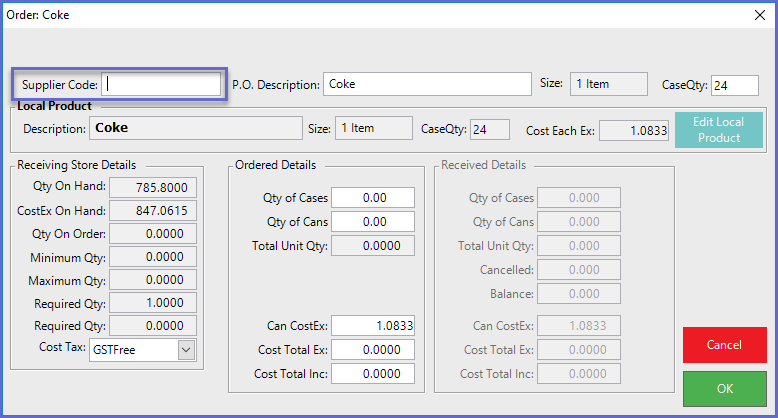
Multiple Supplier Codes & Receiving Invoices via Supplier Communications
- When using
Supplier Comms toReceive Electronic Invoices , if the Supplier Code for a Product that is received matches any of the Supplier Codes already maintained in the database, the Product will be matched - For example, if a Product has two (2) Supplier Codes where one code is used most often and the other is used for a special edition (Christmas packaging in this case), but are otherwise the same Product and should not be duplicated in the database
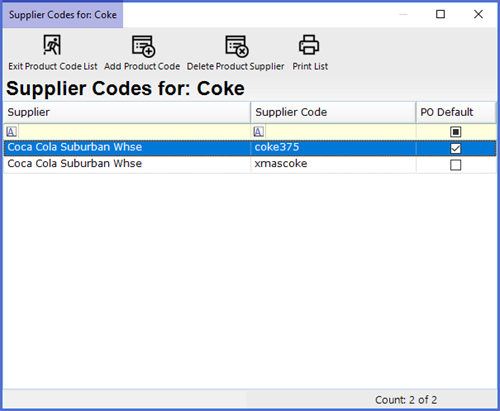
- When using Supplier Comms to receive an Invoice which is using an alternate Supplier Code than the Supplier Code marked as PO Default, the Product will be matched when being Received and the PO Default Supplier Code will appear on the Received Purchase Order
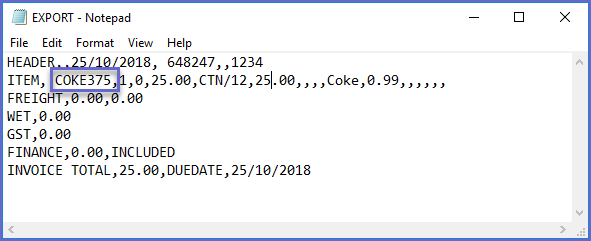
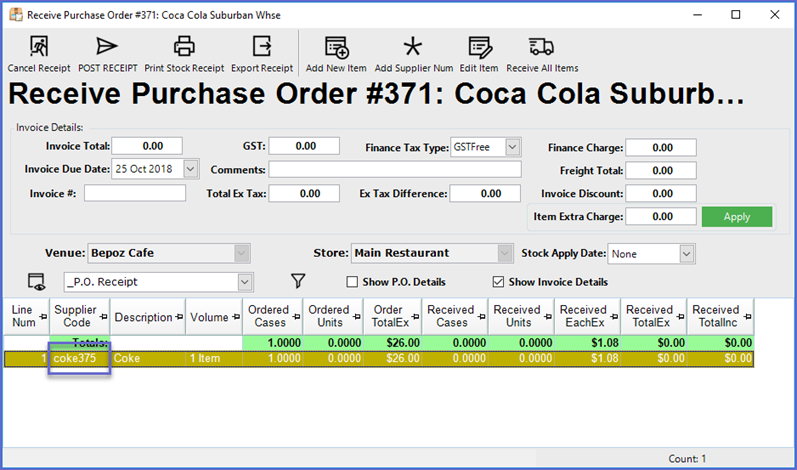
- This eliminates the process of selecting a local product when a Supplier Code isn't matched, as seen below
- After a Product has been selected for a previously unmatched Supplier Code, that Supplier Code will be added the database and will become the PO Default for that Product
Related Material
-
Multiple Supplier Codes per Product -
Creating & Posting a New Purchase Order using a Blank P.O.
